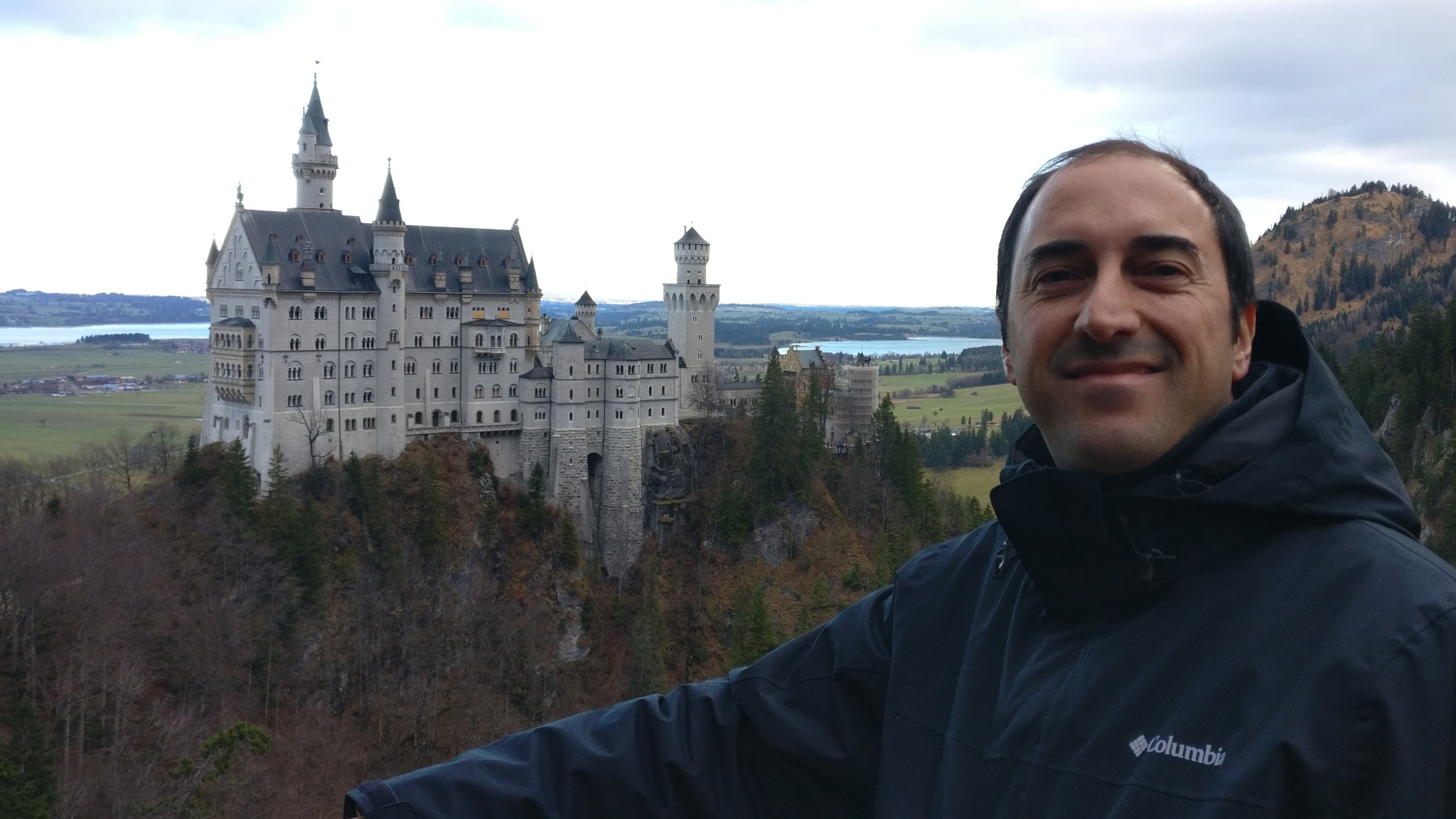
Some weeks ago I had the pleasure to make again an awesome road trip with my friend Agatha, this time through the German Romantische Strasse. It is not the first (and most probably will not be the last) trip together, you can read about my trips with her through Scotland, Austria, Brittany or Normandy (and we have made a few more).
I’m adding the German adjective to the title because last year I also traveled through the Austrian Romantikstrasse. We discovered after that trip that a similar one existed in Germany, so it was about time to travel the german one at least to compare. For your information, there are similar routes in Japan, Korea and Brazil. I neither confirm nor deny that now I want to follow those as well (damn completism).
I really needed some holidays to disconnect (this year has been difficult and complex in several ways) and I love to travel in December through central Europe to feel their passion for the X-Mas season and the mulled wine or glühwein as they call it. Sadly we couldn’t plan a lot in advance (again) but we could at least prepare a draft planning of the places we wanted to visit in those eleven days. We planned (and booked) a couple of days for Dachau and Nuremberg at the beginning of the trip and some days in Munich at the end, 2-4 days depending on the required time for our main priority: The Romantische Strasse.
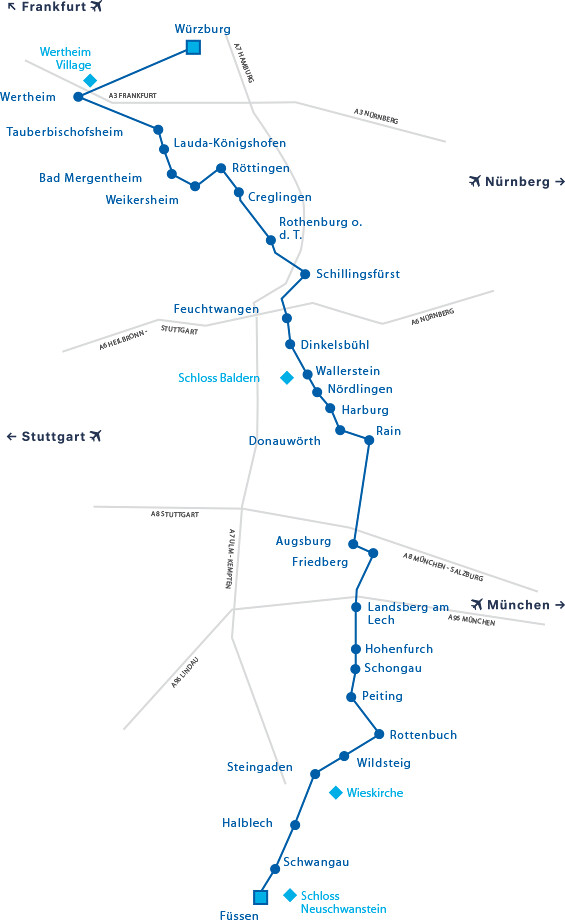
In 11 days I drove 1.035 kilometers, we visited 20 towns/cities, I took almost 1.200 photos and we found 30 caches!!
Let me summarize our experience in the main stops of the trip. Let’s start!
Dachau Concentration Camp Memorial Site
After having visited Auschwitz and Mauthausen more or less recently, I was not as impressed as others can be with Dachau but that is only my bias, because Dachau Memorial clearly is worth of a visit.
The preserved part of the original camp is minimum, so the special attractive of Dachau for me was the permanent exhibition located in the former maintenance building, the biggest standing building from the original camp. The explanation about what Dachau was, how it worked and its role in the overall strategy of the Nazis is quite detailed and interesting. They were so proud of the (awful) results that they exported it to other concentration camps as the Dachau model.
At the end of the original concentration camp there are several religious temples of different religious faiths. Some of them were closed but in the end they mainly aim at religious people from that specific faith. Nothing to do with the spectacular memorials in Mauthausen, for example.
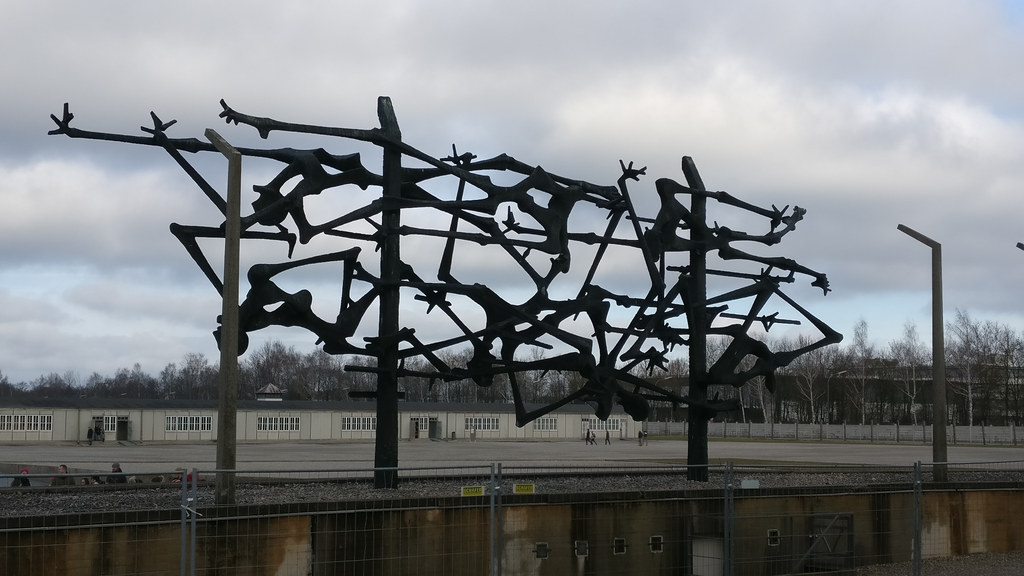
Nuremberg
We spent almost 1,5 days in Nuremberg, a wonderful place that exceeded my expectations (and they were high). Everything was invaded by tourists because of the seasonal stuff so we happily joined the flock and we walked calmly through all the X-Mas Market stalls, with special attention to the Glühwein ones. We walked a lot through the city center and I loved almost everything that we saw: the Henkersteg (Hangman’s Bridge), the Maxbrücke, the Ehekarussell, the Handwerkerhof (Craftmen’s Courtyard) and lots of other beautiful streets and buildings. The only locations that we visited properly were the Imperial Castle and the Toy Museum.
The Toy Museum would be interesting just for the fact of having an entire building packed full with toys (some of them new but mostly vintage). Children will enjoy it but also adults of all ages, going through several cabinets of what could have been their toys. One section was entitled for the evolution of the toy concept, where they emphasized the current phenomenon with children flooded by short-lived play stuff, often endangering their creative playing skills. An interesting thought that I mostly share.
The Imperial Castle is probably the main attraction in Nuremberg. As almost everything else it was vastly destroyed in the II World War but they successfully rebuilt the entire complex as it was before the war. The exhibition is quite interesting, combining clear explanations of the elements of the Castle in their historical context with information about the Holy Roman Empire and the role of the city in that late Middle Ages. I still raise my eyebrows remembering the visit to the Tiefer Brunnen (The Deep Well), you should not miss it.

I loved to see Nuremberg in X-Mas but I will try to visit again in another season as there is a lot more to see.
Würzburg
In Würzburg we repeated the tactic. We arrived in the evening to see the city after dawn, and in the next morning we visited the main attraction: the Würzburg Residence, a clear masterwork of German Baroque.

Here we found again some of the places closed (some of them closed for the entire winter) but in overall the town looked fantastic and also worth for another visit at least to see the Gardens and the Marienberg Fortress (that was closed for the entire Winter).
Tauberbischofsheim
After leaving Würzburg we made a quick stop in Tauberbischofsheim. We could just visit the Saint Martin church as the rest was closed for the winter, but the visit was worthy anyway. The medieval old town is fantastic and very well preserved, including an interesting Neo-Gothic town hall. We left after a quiet meal watching an intense rain fall through the windows.

Bad Mergentheim
We left Bad Mergentheim after one evening and part of the next morning without been able to visit the Castle of the Teutonic Order and the Teutonic Order Museum but in overall it was again a nice visit because the old town was splendid, specially with the seasonal lights and stalls. The heavy rain continued so we had little more to do.
Weikersheim
Weikersheim was one of the biggest surprises of the trip. The old town was also cute, but I want to highlight the Weikersheim Castle, a fabulous Renaissance palace with Baroque gardens.
The 40 meters long Knights’ Hall at the Palace is the most astounding thing that I have seen in ages. It is dedicated to hunting and secret worlds, and any visitor will be amazed by dozens of life-size three-dimensional figures of wildlife animals made in painted stucco, mostly of those that could be hunted in the surroundings but also including exotic pieces like an elephant. The wooden ceiling is also entirely covered with pictures of hunting scenes mixed with local legends. A unique place.
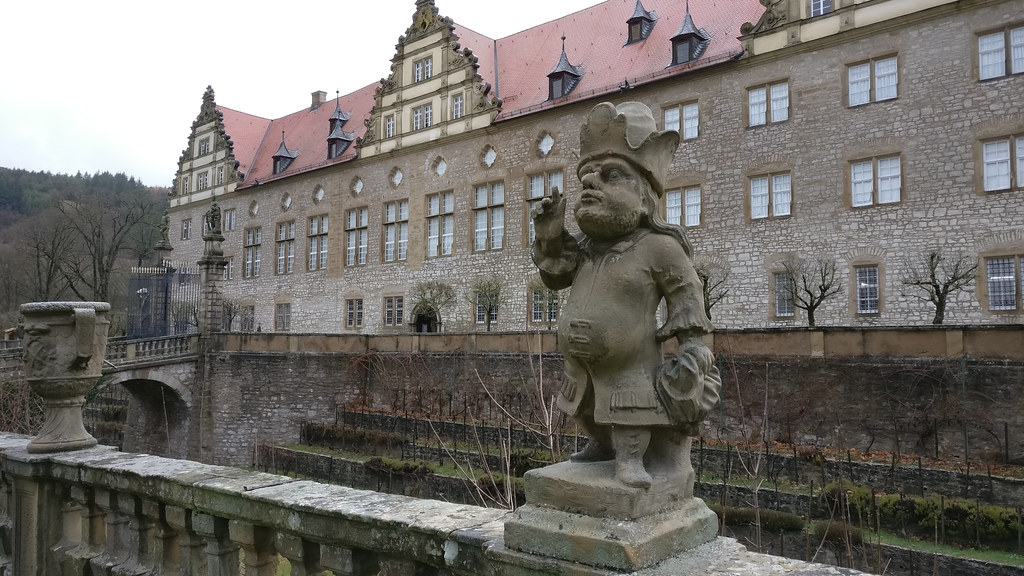
We enjoyed a lot the Castle, if any of the other places that we found closed are similar the Romantische Strasse will clearly worth a second visit.
We also visited the Sternwarte Weikersheim Observatory, just in case it was open, but we were unlucky again.
Röttingen
Röttingen was another quick visit before lunch. Their well preserved medieval fortifications and old town deserved a visit. The Brattenstein Castle looked nice, it was closed but we could at least see that it also serves as a small open air theater. Another interesting place in seasons with better weather conditions.
We also discovered a sun-dial hike trail around the town, with a different type of sun-dial in each stop. Nice also for longer stays.
Rothenburg ob der Tauber
Rothenburg ob der Tauber was probably the town that I enjoyed the most from the entire Romantische Strasse. It does not have an iconic place (like a fine Palace or a landmark Castle) but the entire old town is somehow magical. The battlements that surround its huge medieval center can be traversed (and we did it) for a length of 2.5 km, allowing anyone to surround from the heights almost the complete perimeter.
We only visited one Museum out of pure curiosity, the German Christmas Museum. The Museum itself is interesting but not an unforgettable place, but the free-entry Christmas decoration shop behind (or around) it is completely amazing and singular. In fact, the Museum is inside this huge shop that belongs to a famous German company that sells Christmas decorations in several stores across Germany and in some other locations worldwide. This one is the head office and it is open all year long, claiming to have the world’s largest selection of traditional Christmas ornaments. It totally deserves a visit, if you are disciplined and you can resist the temptation to buy things like crazy.
During the highly advisable Night Watchman walking tour we heard some interesting stories. One of them caught my attention so I will summarize it for you, after having confirmed its authenticity. March 1945, II World War is about to end but some German soldiers are barricaded here taking advantage of the huge city wall. Lots of bombs are dropped killing dozens of people and destroying >300 buildings, several watchtowers and part of the wall. In that moment the U.S. Assistant Secretary of War, John J. McCloy, knowing (allegedly) about the beauty of Rothenburg orders to stop immediately the artillery attacks and gives three hours to a small group of American soldiers to negotiate the surrender of the town, or it will be bombed massively. At that moment in time Rothenburg was not as touristic as it is today and it was pure luck (almost miracle, according to the watchman) that the mother of Mr McCloy had a painting of the town at home that the Assistant Secretary of War had seen several times as a child, hearing wonderful stories about the place. The local Nazi commander, agreeing on the importance of preserving the city, betrayed Hitler’s direct orders and committed treason surrendering the city. Since November 1948 McCloy is also honorary citizen of Rothenburg.
The Watchman gave us also another thought provoking insight: Rothenburg was severely depopulated in the 17th century by the Thirty Years’ War and a bubonic plague outbreak and its economy was a mess during a couple of centuries. It was not until the end of the 19th century when several artists from the german Romanticism visited the place with the first tourists and some regulations were created to prevent major changes in the old town. In some way, as he told us thankfully, all the current economic wealth is thanks to a long lasting extreme poverty that preserved the 16th-17th century state.
I really need to stop writing about this place if I want to finish this chronicle, but before going to the next one let me show you the most picturesque, photographed and painted place in Rothenburg.
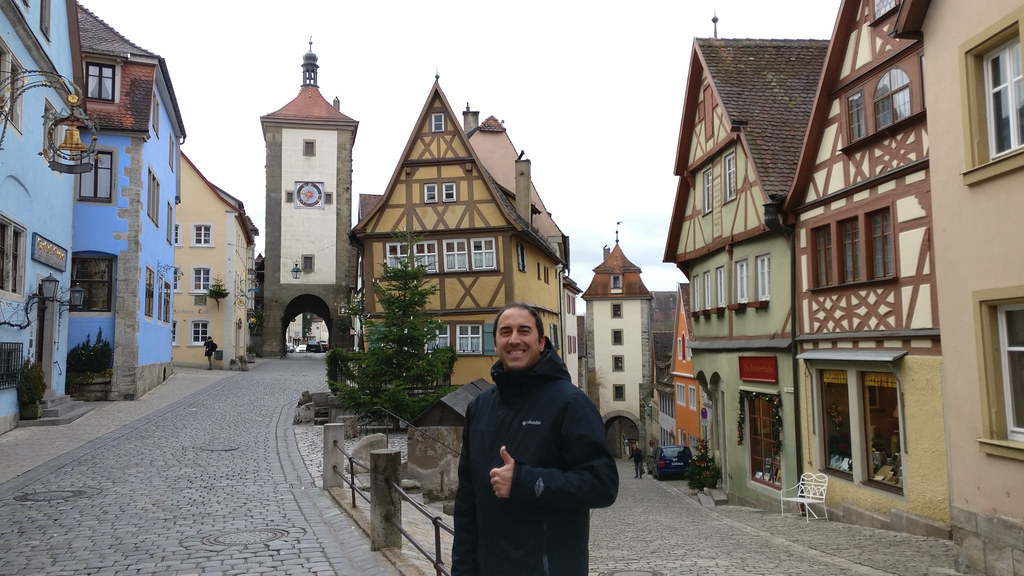
Dinkelsbühl
We stopped at Dinkelsbühl during the lunch time, in order to eat something nice there and apparently we made a usual plan, according to the huge amount of restaurants that Dinkelsbühl has. After lunch we made a nice walking tour though the city center with some daylight surrounding the whole town center inside and outside the city wall.
There are interesting places to see/visit here like a 3rd Dimension Museum but my suggestion is to at least walk calmly through it, passing through some of the splendid gates of the wall: the Wörnitz gate, the Segringen gate, the Nördlingen gate or the Rothenburg gate to name the most beautiful ones.
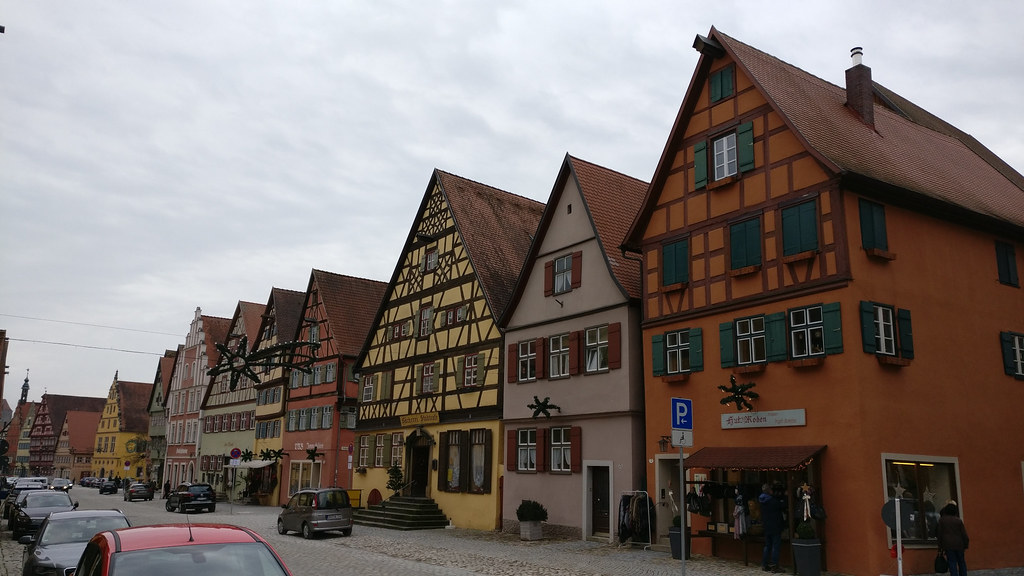
Nördlingen
We arrived in Nördlingen in the evening, so again we walked through it at night, to enjoy the seasonal decoration and the X-Mas Market delicacies, and we walked it again calmly in the following morning.
Again, as in Dinkelsbühl and Rothenburg ob der Tauber, this is the third fully walkable battlements that can be traversed (the only three in Germany) surrounding, in this case for more than 2.5 km, an almost perfectly preserved medieval town center. I suppose that reading this summary it all sounds quite similar but in reality each town had its own personality and touch, so our visits were not overlapping with the previous ones but adding a lot to a great overall experience.
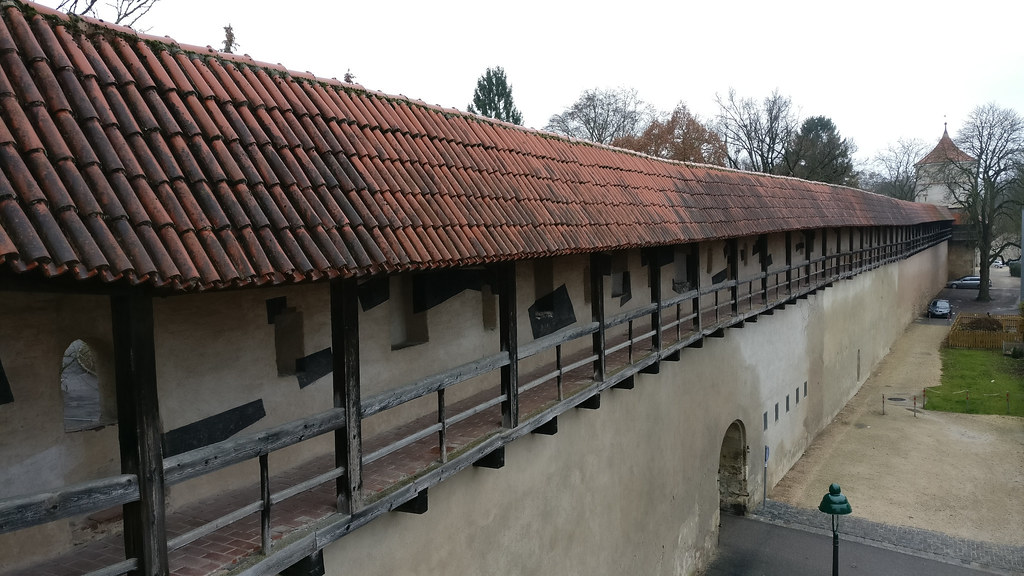
The city was built in the middle of a meteorite impact crater, so they have the the Rieskrater Museum dedicated to the crater explaining some geological facts. Another important museum in Nördlingen is the Bayerische Eisenbahnmuseum with more than one hundred original railway vehicles. We could not visit them but for a longer stay here they are quite interesting.
Augsburg
We spent the rest of the morning in Donauwörth (nice but nothing remarkable) to finally arrive in Augsburg again in the late afternoon.
Augsburg was for me, undoubtedly, one of the most special stages of the trip. The seasonal markets were again everywhere with a noticeable quality in the products and decorations, even in the Glühwein (I plead guilty of tasting them all) and the city itself is gloriously beautiful. Lots of buildings and scenes breath history through their doors and walls.
Again, we could not visit everything we wanted (for example the Mozart House, where the composer’s father Leopold was born and the musician visited several times) but the places we visited were amazing. The Maximilian Museum of decorative arts was remarkable, the Cathedral was nice but the most clear must see of the town is the Goldener Saal (Golden Hall) in the Town Hall, a >550 square meters hall with large murals and numerous ceiling paintings all of them richly adorned with golden frames and decoration. Astonishing. During the visit we learned that it was badly damaged during the II World War and it was renovated and redecorated between the 80s and 90s, according to historical photographs and blueprints.
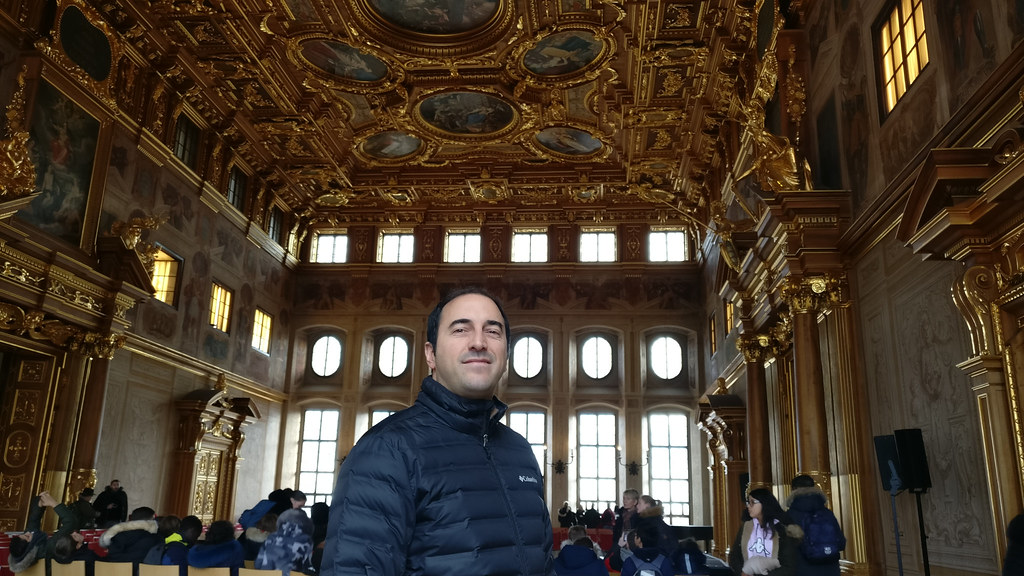
Landsberg am Lech
Landsberg am Lech was a last minute addition to our trip. We initially discarded it but we finally went there and we did not regret at all. It is a small town, with little to see apart from its nice streets but at least I wanted to visit in person a picturesque tower that is located there: the Mutterturm.
What we found was a lively town center with several people enjoying the X-Mas market delicacies (yes, lots of Glühwein again) that forced us to extend our stay. In our way back from the car, after putting a new parking ticket, a fabulous sunset with a bright rainbow totally surprised us. A perfect spot with the perfect timing.

Neuschwanstein and Hohenschwangau Castles
The municipality of Schwangau would not be a stop on any route if it were not for the two wonders that it has in its touristic suburb of Hohenschwangau: the Hohenschwangau Castle and specially the Neuschwanstein Castle.
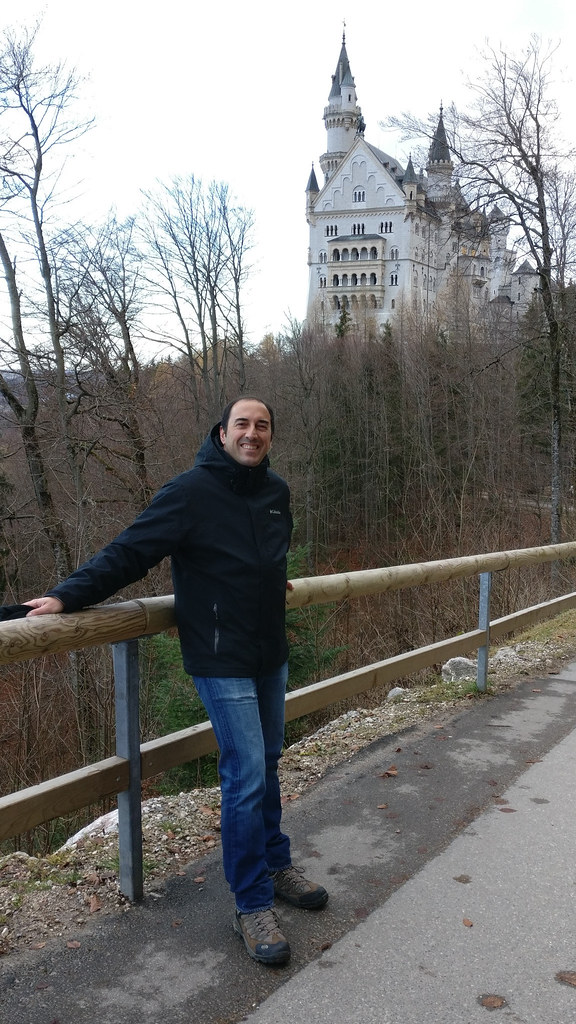
The Neuschwanstein Castle is one of those worldwide known locations capable itself of receiving millions of visitors from all around the globe. According to Wikipedia, more than 1.3 million people visit the castle annually making it one of the most visited places in the world. I’m not surprised, especially after having visited the Castle personally.
Visiting Neuschwanstein is a comfortable and amazing experience. Our german friends have managed to allow its thousands of daily visitors to enjoy the castle without queues, almost without big crowds and without being shoved. In order to do this you just need to book your ticket in advance for a very specific day and time (they claim that you will not be able to enter if you arrive slightly late), as the castle can only be visited with a guided tour that lasts about 40-45 minutes.
As an alternative, and that is what we did, you can always go to the official ticket center in Hohenschwangau to buy a ticket for any tour with available capacity for that the same day. We took the risk, arriving the ticket center almost an hour before the opening time, and the plan worked perfectly. With only a dozen of people in front of us (maybe a hundred behind when the doors opened) we were able to get the tickets we wanted for both castles at the most appropriate time slots for us.
But there are thousands of pages and books about the place and the logistics, so let me focus again in my experience there.
Neuschwanstein is the perfect climax for the Romantische Strasse. It is an incredible combination of the best architectural techniques and craftsmanship with the overflowing imagination of the most creative artists of that time. The overall theme are the operas of Richard Wagner based as well normally on medieval legends: The Ring of the Nibelung, Tristan and Isolda or Parsifal among others. As you probably know the castle was commissioned (and paid out of his personal fortune) by King Ludwig II of Bavaria that was admirer and later friend and (so they say) even lover of Wagner himself.
I left the castle, after the non-stopping breathtaking tour, with the feeling that everything was perfectly located, designed, painted or illuminated, to the smallest detail. If at some point I become a millionaire, and that is difficult because I do not steal neither play any lottery, I think I will build a similar castle themed in fantastic genre legends. Dreams are cheap.
Bonus recommendation: Even if you hike to the castle don’t forget to go further up to the Marienbrücke, a spectacular steel bridge (originally made of wood) that crosses a huge gorge from where you will have the best perspective of the castle. The bus that takes you to the castle for non-hikers has its closest stop to the castle near the bridge.

Hohenschwangau Castle is a 19th century palace built by King Maximilian II of Bavaria, and childhood residence of his famous son King Ludwig II. According to the Wikipedia, Hohenschwangau has 300k visitors per year, far away from the astounding numbers of Neuschwanstein. It’s clearly not as spectacular but having visited the location it does not make sense to me that 75% of the visitors leave Hohenschwangau without visiting this second marvel.

You can also (and probably should) visit the Museum of the Bavarian Kings. It is nothing compared to the Castles but will give you more insights and an interesting context if you visit it before going to the Castles. Also, you don’t book any specific hour to see it so you can use any free time slot during the day to go, quite convenient.
Munich
I will be very brief, because this post is already too long and also because I am quite sure that I will go back sooner than later for a detailed visit because I loved the city.
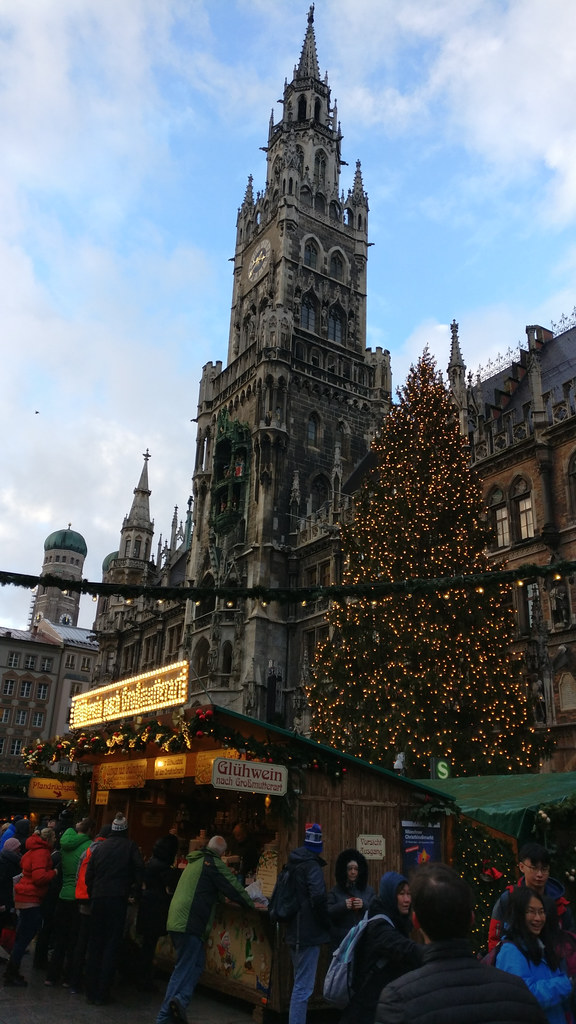
Munich, the famous capital of Bavaria, could not and did not disappoint us. It has a well deserved appreciation from tourists, and during the X-Mas it is perhaps more remarkable because it is one of the most popular Christmas destinations in the region, along with Nuremberg. Again, we could not visit some of the main attractions but visited some amazing places and we enjoyed ourselves strolling though its streets and X-Mas market stalls.
Upon arrival we visit the Nymphenburg Palace, a wonderful Baroque palace surrounded by a huge garden in which we could only see a corner. It was raining and sometimes snowing during our visit so the garden will probably be also my first visit if I go back again to Munich during the sunny part of the year.
The Palace served as Summer Residence for the Bavarian royal family for centuries, King Ludwig II was born there in August 1845. The visit is really worth it as you can enjoy several rooms and pavilions with lots of artworks and rich decoration. My favorite attraction there was the Gallerie of Beauties of King Ludwig I, a set of really nice portraits by the same painter (Joseph Karl Stieler) on behalf of the king to 36 beautiful women from all social classes of Munich. The audio guide described the best-known works with all the relevant context but a few others made me curious, maybe one day I will research more about it.
We also wanted to see at least one of the many important art galleries of the city, and I think it was a great choice to visit the Alte Pinakothek. The Old Picture Gallery name refers to the time period covered by the collection, as they also have the Neue Pinakothek nearby. I was amazed by many great painters, most of them new to me: Carl Spitzweg, Gabriel von Max, Walter Crane, David Wilkie, Ludwig Richter or Johan Christian Dahl to name just a few.
I could not remember all those names to the point that after visiting the museum I made the complete tour again very very quickly taking photos of the pictures and the inscription plates of my favorite ones to discover more at home. I made it walking very fast, almost running, so even a nice elder man stopped me to say: “see, they sell the collection catalog in the shop so you don’t need to picture everything and leave if you are in a hurry”, I explained him that it was my second round and that I was in love with the museum and we laughed for a while.
Bonus recommendation: Do not visit this museum without using the audio guide, it was one of the best ones I have ever used. Not only they described the masterworks, they did it with nice music along with the texts and sometimes mixed with stories that gave a complete new meaning to the picture. At least the one in English, I always use the English one as sometimes it is more carefully prepared or detailed.
The other remarkable and marvelous location that we visited was the Munich Residenz, the larges city palace in Germany where you can visit more than 130 rooms and pavilions. It is impressive not only because of the size but also because of the importance and beauty of the collection. Many things to highlight: The Hall of Antiquities, the Ancestral Gallery, the Grottenhof, the Royal Apartments, the Golden Hall,…

As my twitter followers know (more details in this thread), we had an unspeakable amount of Glühwein during this trip. They served it always and everywhere in ceramic or crystal mugs, avoiding the usage of non re-usable cups that normally end up in the floor or overflowing trash cans. They charged a 3-4 € deposit so you were also free to keep it as a souvenir. Furthermore, in each town (and in the bigger towns even in each market stall) they served the mulled wine in a different mug, some of them nicer than others. We were tempted to keep all of them, but it was not scalable (neither in money nor in luggage requirements) so finally I just kept three from my favorite towns of the trip: Nuremberg, Augsburg and Munich:
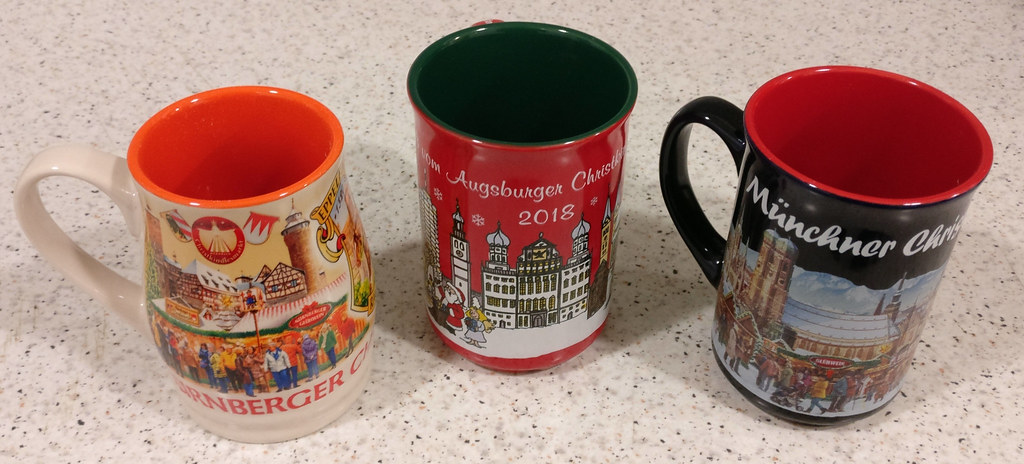
And that is all!! I hope that you enjoyed the guide!





